Impact of Customer Perceived Value on Satisfaction: MBO Cinemas Case
VerifiedAdded on 2023/06/16
|104
|29176
|436
Thesis and Dissertation
AI Summary
This thesis investigates the impact of customer perceived value (CPV) on customer satisfaction within the entertainment industry, focusing on MBO Cinemas in Malaysia. Using a sample of 100 respondents, the study employs a questionnaire to gather data on functional, social, emotional, economic, and conditional values. The results indicate that these values significantly influence customer satisfaction in the Malaysian entertainment sector. Statistical analysis reveals positive correlations between all considered values and customer satisfaction, suggesting that a holistic approach to enhancing these values can improve customer retention and overall business performance for MBO Cinemas. The research provides recommendations for MBO Cinemas to focus on key value drivers to improve customer satisfaction and suggests areas for future research.
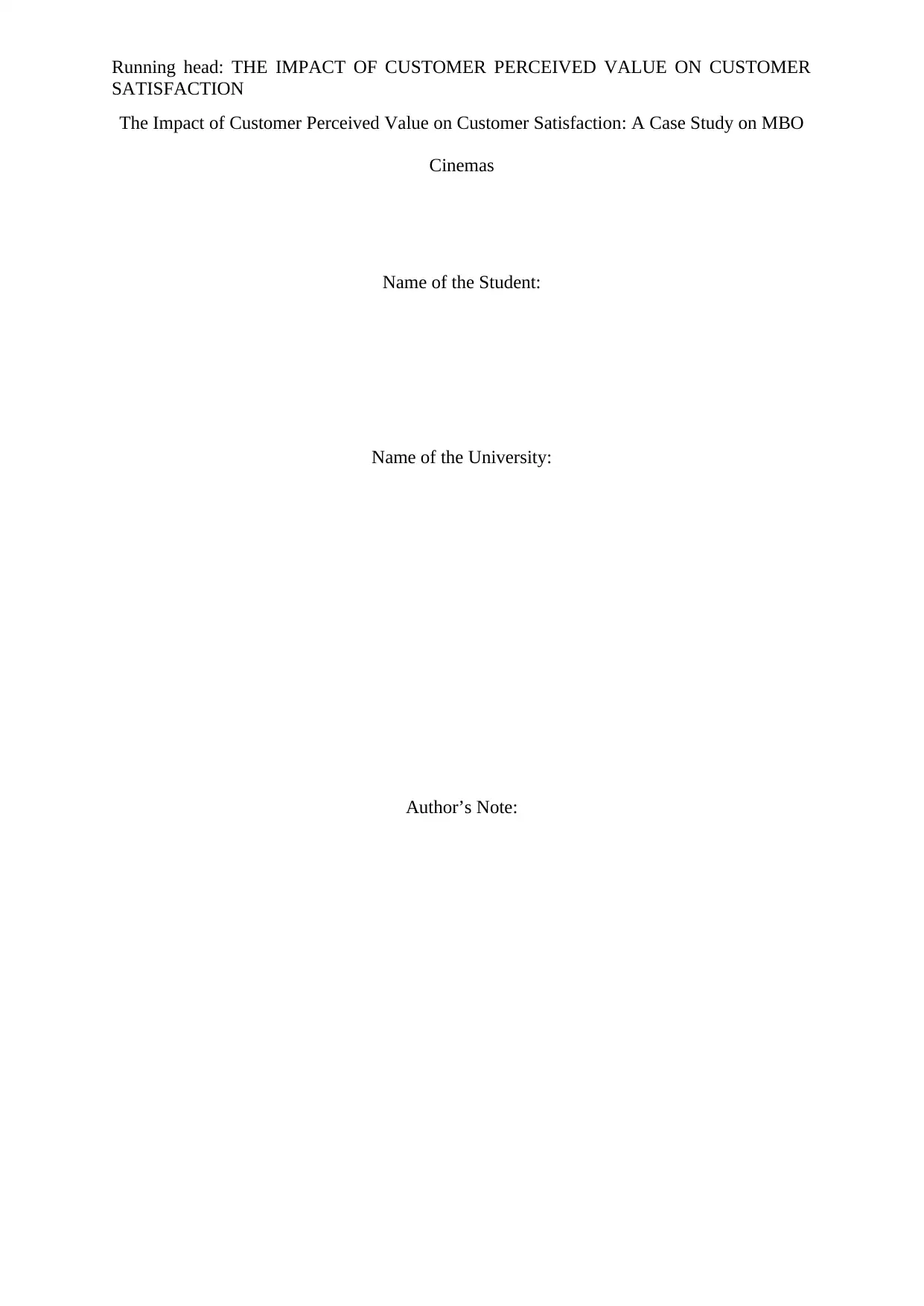
Running head: THE IMPACT OF CUSTOMER PERCEIVED VALUE ON CUSTOMER
SATISFACTION
The Impact of Customer Perceived Value on Customer Satisfaction: A Case Study on MBO
Cinemas
Name of the Student:
Name of the University:
Author’s Note:
SATISFACTION
The Impact of Customer Perceived Value on Customer Satisfaction: A Case Study on MBO
Cinemas
Name of the Student:
Name of the University:
Author’s Note:
Paraphrase This Document
Need a fresh take? Get an instant paraphrase of this document with our AI Paraphraser
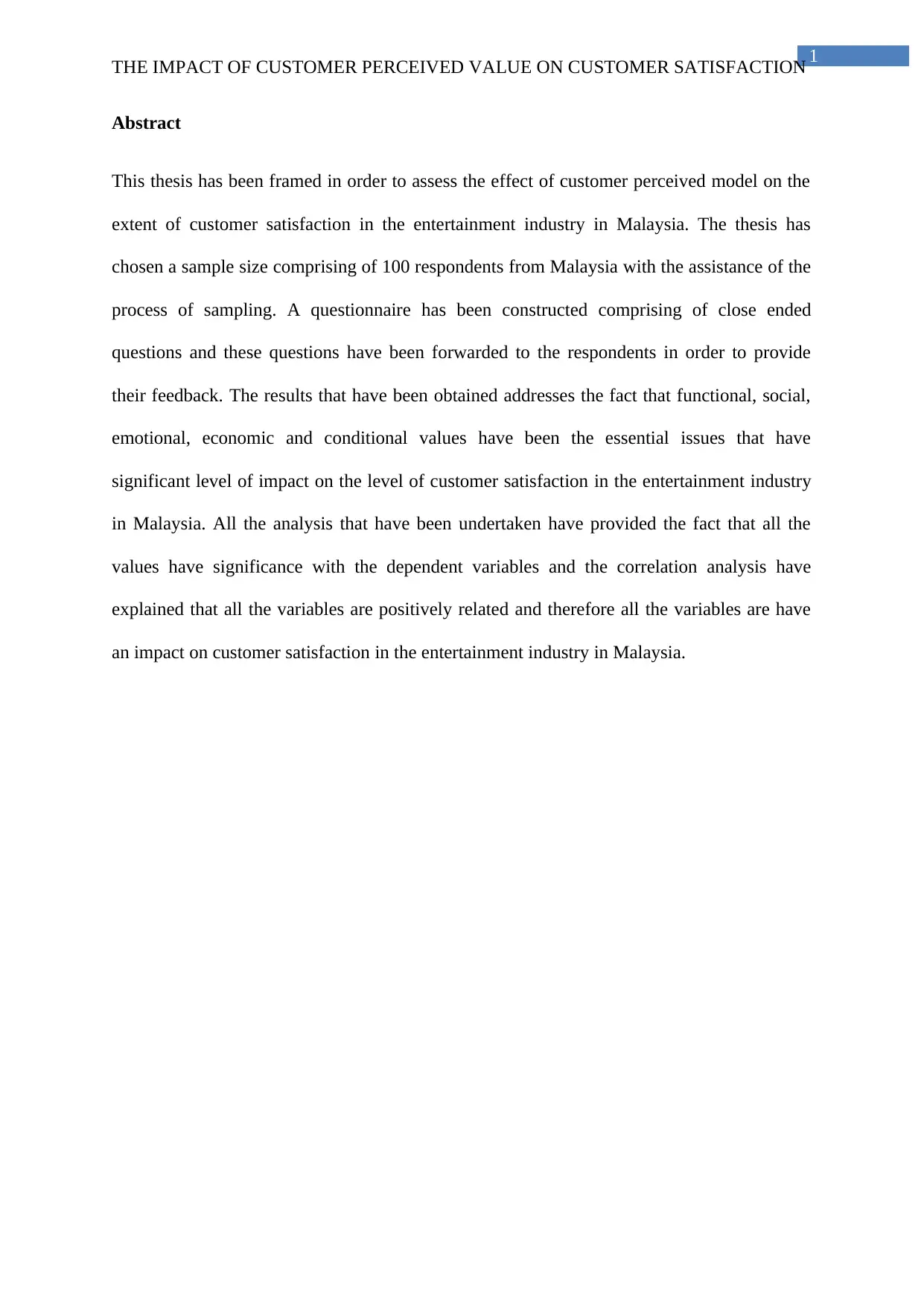
1
THE IMPACT OF CUSTOMER PERCEIVED VALUE ON CUSTOMER SATISFACTION
Abstract
This thesis has been framed in order to assess the effect of customer perceived model on the
extent of customer satisfaction in the entertainment industry in Malaysia. The thesis has
chosen a sample size comprising of 100 respondents from Malaysia with the assistance of the
process of sampling. A questionnaire has been constructed comprising of close ended
questions and these questions have been forwarded to the respondents in order to provide
their feedback. The results that have been obtained addresses the fact that functional, social,
emotional, economic and conditional values have been the essential issues that have
significant level of impact on the level of customer satisfaction in the entertainment industry
in Malaysia. All the analysis that have been undertaken have provided the fact that all the
values have significance with the dependent variables and the correlation analysis have
explained that all the variables are positively related and therefore all the variables are have
an impact on customer satisfaction in the entertainment industry in Malaysia.
THE IMPACT OF CUSTOMER PERCEIVED VALUE ON CUSTOMER SATISFACTION
Abstract
This thesis has been framed in order to assess the effect of customer perceived model on the
extent of customer satisfaction in the entertainment industry in Malaysia. The thesis has
chosen a sample size comprising of 100 respondents from Malaysia with the assistance of the
process of sampling. A questionnaire has been constructed comprising of close ended
questions and these questions have been forwarded to the respondents in order to provide
their feedback. The results that have been obtained addresses the fact that functional, social,
emotional, economic and conditional values have been the essential issues that have
significant level of impact on the level of customer satisfaction in the entertainment industry
in Malaysia. All the analysis that have been undertaken have provided the fact that all the
values have significance with the dependent variables and the correlation analysis have
explained that all the variables are positively related and therefore all the variables are have
an impact on customer satisfaction in the entertainment industry in Malaysia.
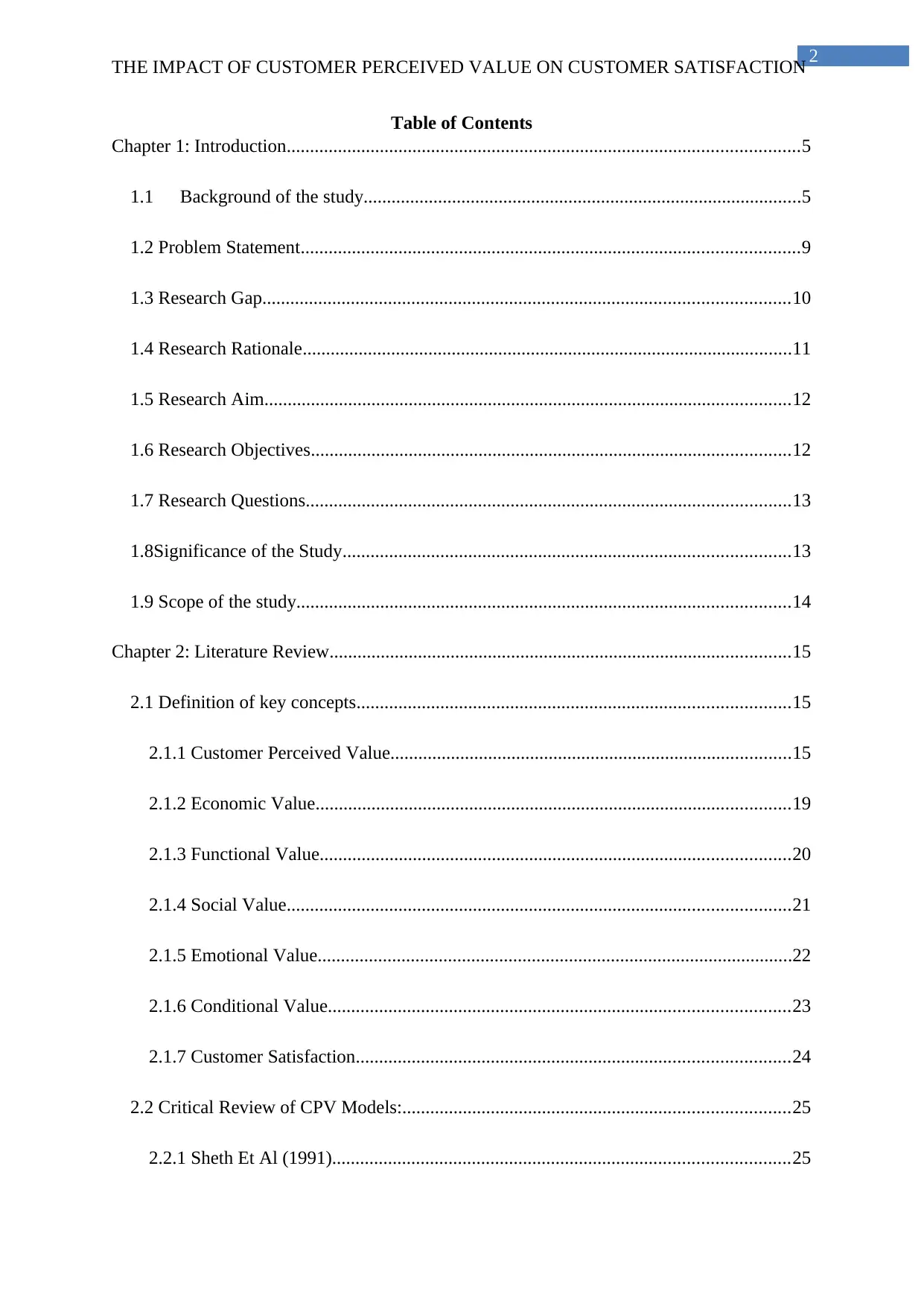
2
THE IMPACT OF CUSTOMER PERCEIVED VALUE ON CUSTOMER SATISFACTION
Table of Contents
Chapter 1: Introduction..............................................................................................................5
1.1 Background of the study..............................................................................................5
1.2 Problem Statement...........................................................................................................9
1.3 Research Gap.................................................................................................................10
1.4 Research Rationale.........................................................................................................11
1.5 Research Aim.................................................................................................................12
1.6 Research Objectives.......................................................................................................12
1.7 Research Questions........................................................................................................13
1.8Significance of the Study................................................................................................13
1.9 Scope of the study..........................................................................................................14
Chapter 2: Literature Review...................................................................................................15
2.1 Definition of key concepts.............................................................................................15
2.1.1 Customer Perceived Value......................................................................................15
2.1.2 Economic Value......................................................................................................19
2.1.3 Functional Value.....................................................................................................20
2.1.4 Social Value............................................................................................................21
2.1.5 Emotional Value......................................................................................................22
2.1.6 Conditional Value...................................................................................................23
2.1.7 Customer Satisfaction.............................................................................................24
2.2 Critical Review of CPV Models:...................................................................................25
2.2.1 Sheth Et Al (1991)..................................................................................................25
THE IMPACT OF CUSTOMER PERCEIVED VALUE ON CUSTOMER SATISFACTION
Table of Contents
Chapter 1: Introduction..............................................................................................................5
1.1 Background of the study..............................................................................................5
1.2 Problem Statement...........................................................................................................9
1.3 Research Gap.................................................................................................................10
1.4 Research Rationale.........................................................................................................11
1.5 Research Aim.................................................................................................................12
1.6 Research Objectives.......................................................................................................12
1.7 Research Questions........................................................................................................13
1.8Significance of the Study................................................................................................13
1.9 Scope of the study..........................................................................................................14
Chapter 2: Literature Review...................................................................................................15
2.1 Definition of key concepts.............................................................................................15
2.1.1 Customer Perceived Value......................................................................................15
2.1.2 Economic Value......................................................................................................19
2.1.3 Functional Value.....................................................................................................20
2.1.4 Social Value............................................................................................................21
2.1.5 Emotional Value......................................................................................................22
2.1.6 Conditional Value...................................................................................................23
2.1.7 Customer Satisfaction.............................................................................................24
2.2 Critical Review of CPV Models:...................................................................................25
2.2.1 Sheth Et Al (1991)..................................................................................................25
⊘ This is a preview!⊘
Do you want full access?
Subscribe today to unlock all pages.

Trusted by 1+ million students worldwide

3
THE IMPACT OF CUSTOMER PERCEIVED VALUE ON CUSTOMER SATISFACTION
2.2.2 Rintamaki Et Al (2006)...........................................................................................27
2.2.3 Holbrook perspective of customer perceived value (1994)....................................28
2.2.4 Monroe (1985)........................................................................................................29
2.3 Empirical Studies Malaysia............................................................................................31
2.4 Empirical Studies Global Context..................................................................................32
2.5 Hypothesis......................................................................................................................33
2.6 Summary of the variables...............................................................................................36
2.7Conceptual Framework...................................................................................................37
Chapter 3: Research Methodology...........................................................................................38
3.1 Introduction....................................................................................................................38
3.2 Research Paradigm.........................................................................................................38
3.3 Research Design.............................................................................................................39
3.4 Research Strategy...........................................................................................................40
3.5 Data Collection Method.................................................................................................40
3.6 Data Instrument..............................................................................................................41
3.7 Questionnaire Development...........................................................................................41
3.8 Target Population...........................................................................................................43
3.9 Sample Size and Selection.............................................................................................43
3.10 Data Analysis and Plan................................................................................................44
3.11 Ethical Consideration...................................................................................................46
Chapter 4: Data Analysis and Discussion................................................................................47
THE IMPACT OF CUSTOMER PERCEIVED VALUE ON CUSTOMER SATISFACTION
2.2.2 Rintamaki Et Al (2006)...........................................................................................27
2.2.3 Holbrook perspective of customer perceived value (1994)....................................28
2.2.4 Monroe (1985)........................................................................................................29
2.3 Empirical Studies Malaysia............................................................................................31
2.4 Empirical Studies Global Context..................................................................................32
2.5 Hypothesis......................................................................................................................33
2.6 Summary of the variables...............................................................................................36
2.7Conceptual Framework...................................................................................................37
Chapter 3: Research Methodology...........................................................................................38
3.1 Introduction....................................................................................................................38
3.2 Research Paradigm.........................................................................................................38
3.3 Research Design.............................................................................................................39
3.4 Research Strategy...........................................................................................................40
3.5 Data Collection Method.................................................................................................40
3.6 Data Instrument..............................................................................................................41
3.7 Questionnaire Development...........................................................................................41
3.8 Target Population...........................................................................................................43
3.9 Sample Size and Selection.............................................................................................43
3.10 Data Analysis and Plan................................................................................................44
3.11 Ethical Consideration...................................................................................................46
Chapter 4: Data Analysis and Discussion................................................................................47
Paraphrase This Document
Need a fresh take? Get an instant paraphrase of this document with our AI Paraphraser
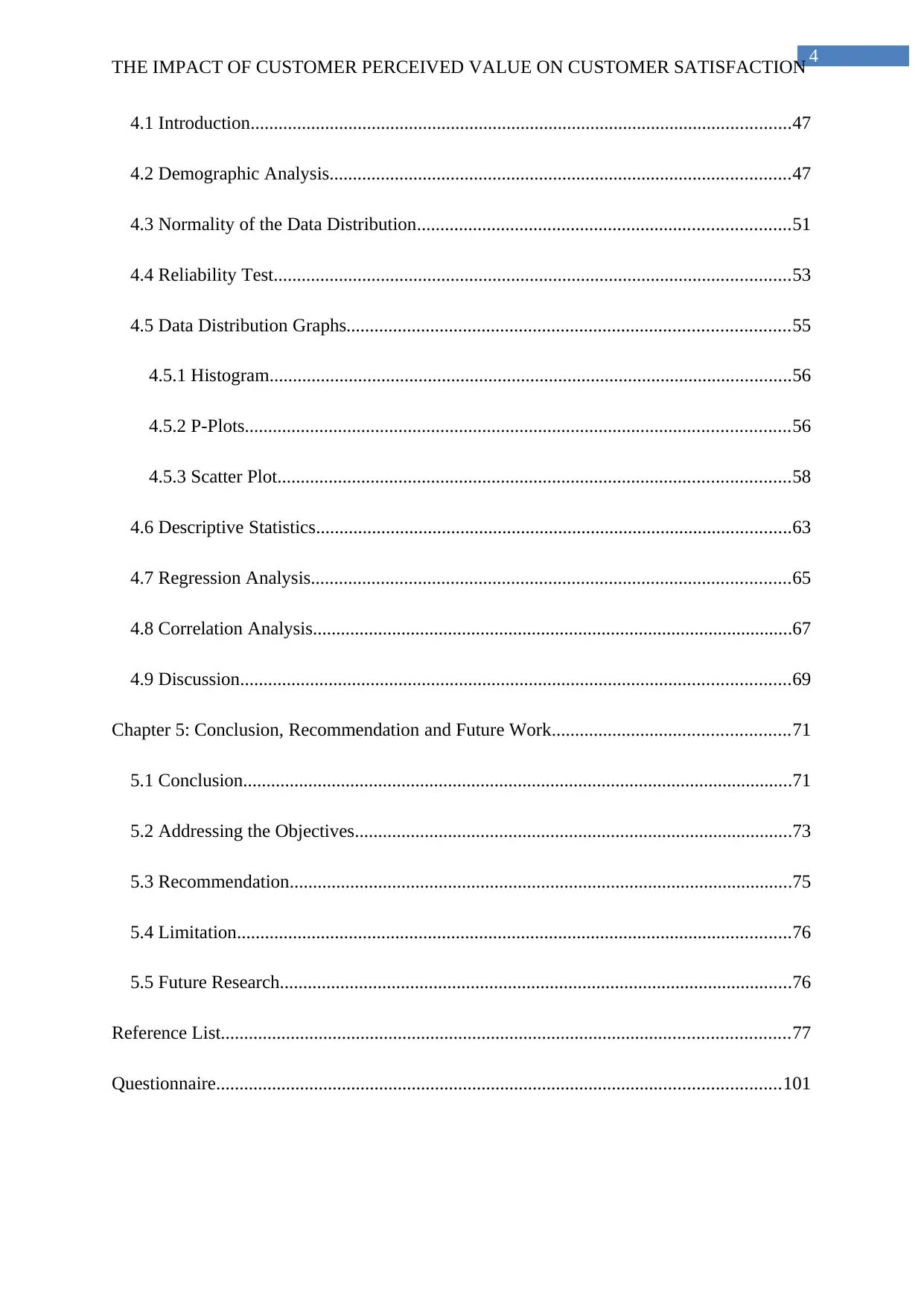
4
THE IMPACT OF CUSTOMER PERCEIVED VALUE ON CUSTOMER SATISFACTION
4.1 Introduction....................................................................................................................47
4.2 Demographic Analysis...................................................................................................47
4.3 Normality of the Data Distribution................................................................................51
4.4 Reliability Test...............................................................................................................53
4.5 Data Distribution Graphs...............................................................................................55
4.5.1 Histogram................................................................................................................56
4.5.2 P-Plots.....................................................................................................................56
4.5.3 Scatter Plot..............................................................................................................58
4.6 Descriptive Statistics......................................................................................................63
4.7 Regression Analysis.......................................................................................................65
4.8 Correlation Analysis.......................................................................................................67
4.9 Discussion......................................................................................................................69
Chapter 5: Conclusion, Recommendation and Future Work...................................................71
5.1 Conclusion......................................................................................................................71
5.2 Addressing the Objectives..............................................................................................73
5.3 Recommendation............................................................................................................75
5.4 Limitation.......................................................................................................................76
5.5 Future Research..............................................................................................................76
Reference List..........................................................................................................................77
Questionnaire.........................................................................................................................101
THE IMPACT OF CUSTOMER PERCEIVED VALUE ON CUSTOMER SATISFACTION
4.1 Introduction....................................................................................................................47
4.2 Demographic Analysis...................................................................................................47
4.3 Normality of the Data Distribution................................................................................51
4.4 Reliability Test...............................................................................................................53
4.5 Data Distribution Graphs...............................................................................................55
4.5.1 Histogram................................................................................................................56
4.5.2 P-Plots.....................................................................................................................56
4.5.3 Scatter Plot..............................................................................................................58
4.6 Descriptive Statistics......................................................................................................63
4.7 Regression Analysis.......................................................................................................65
4.8 Correlation Analysis.......................................................................................................67
4.9 Discussion......................................................................................................................69
Chapter 5: Conclusion, Recommendation and Future Work...................................................71
5.1 Conclusion......................................................................................................................71
5.2 Addressing the Objectives..............................................................................................73
5.3 Recommendation............................................................................................................75
5.4 Limitation.......................................................................................................................76
5.5 Future Research..............................................................................................................76
Reference List..........................................................................................................................77
Questionnaire.........................................................................................................................101

5
THE IMPACT OF CUSTOMER PERCEIVED VALUE ON CUSTOMER SATISFACTION
Chapter 1: Introduction
This section of the paper provides an overview of the background of the research. It
examines the statement of the problem, research objectives and research questions and finally
it will explain the significance, scope and the structure of the thesis.
1.1 Background of the study
For many years the aspect of customer perceived value has been used within the field
of marketing. There has not been extensive level of researches based on this aspect and
therefore a definite explanation on this model is hard to discover. The customer value is the
perceived inclination of the customers for the appraisal of the features of the services and the
products and the performances of the same and the end result that is attained from the use of
the services and the products in order to satisfy the objectives of the customers.
Jha et al. (2017) addressed that customer perceived value has essential significance in
the entertainment industry because of the fact that services should be provided in such
manner so that they are able to serve value to the customers. The attainment of customer
satisfaction is able to determine the effectiveness of the customer perceived model and
customer perceived model is created with the help of the demand that is seen in the market.
The entertainment industry in Malaysia has a crucial role to play as it provides
entertainment services to the individuals in Malaysia and is able to provide leisure and
satisfaction to them. A movie theatre that is even known as cinema that offers entertainment
to the public and with the help of new and thrilling experiences through pictures. Movie
theatres are constructed for commercial purposes that cater to the common public, who attend
the theatres by purchasing tickets. The film is projected with the help of projectors on a large
screen in an auditorium (Eid 2015). In the current scenarios, the theatres have digital
projections and thereby eliminating the need and transport of a physical print of the film.
THE IMPACT OF CUSTOMER PERCEIVED VALUE ON CUSTOMER SATISFACTION
Chapter 1: Introduction
This section of the paper provides an overview of the background of the research. It
examines the statement of the problem, research objectives and research questions and finally
it will explain the significance, scope and the structure of the thesis.
1.1 Background of the study
For many years the aspect of customer perceived value has been used within the field
of marketing. There has not been extensive level of researches based on this aspect and
therefore a definite explanation on this model is hard to discover. The customer value is the
perceived inclination of the customers for the appraisal of the features of the services and the
products and the performances of the same and the end result that is attained from the use of
the services and the products in order to satisfy the objectives of the customers.
Jha et al. (2017) addressed that customer perceived value has essential significance in
the entertainment industry because of the fact that services should be provided in such
manner so that they are able to serve value to the customers. The attainment of customer
satisfaction is able to determine the effectiveness of the customer perceived model and
customer perceived model is created with the help of the demand that is seen in the market.
The entertainment industry in Malaysia has a crucial role to play as it provides
entertainment services to the individuals in Malaysia and is able to provide leisure and
satisfaction to them. A movie theatre that is even known as cinema that offers entertainment
to the public and with the help of new and thrilling experiences through pictures. Movie
theatres are constructed for commercial purposes that cater to the common public, who attend
the theatres by purchasing tickets. The film is projected with the help of projectors on a large
screen in an auditorium (Eid 2015). In the current scenarios, the theatres have digital
projections and thereby eliminating the need and transport of a physical print of the film.
⊘ This is a preview!⊘
Do you want full access?
Subscribe today to unlock all pages.

Trusted by 1+ million students worldwide
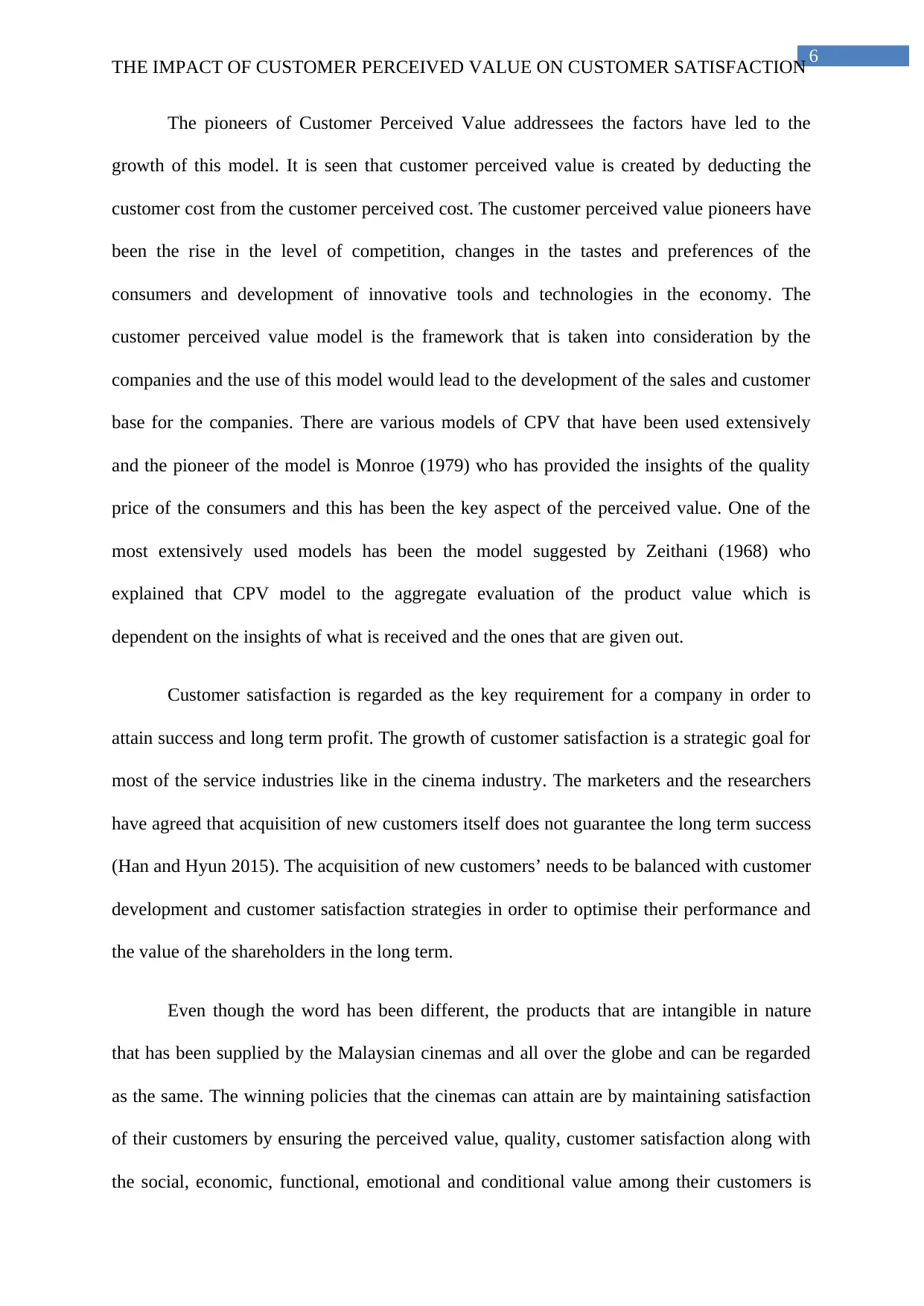
6
THE IMPACT OF CUSTOMER PERCEIVED VALUE ON CUSTOMER SATISFACTION
The pioneers of Customer Perceived Value addressees the factors have led to the
growth of this model. It is seen that customer perceived value is created by deducting the
customer cost from the customer perceived cost. The customer perceived value pioneers have
been the rise in the level of competition, changes in the tastes and preferences of the
consumers and development of innovative tools and technologies in the economy. The
customer perceived value model is the framework that is taken into consideration by the
companies and the use of this model would lead to the development of the sales and customer
base for the companies. There are various models of CPV that have been used extensively
and the pioneer of the model is Monroe (1979) who has provided the insights of the quality
price of the consumers and this has been the key aspect of the perceived value. One of the
most extensively used models has been the model suggested by Zeithani (1968) who
explained that CPV model to the aggregate evaluation of the product value which is
dependent on the insights of what is received and the ones that are given out.
Customer satisfaction is regarded as the key requirement for a company in order to
attain success and long term profit. The growth of customer satisfaction is a strategic goal for
most of the service industries like in the cinema industry. The marketers and the researchers
have agreed that acquisition of new customers itself does not guarantee the long term success
(Han and Hyun 2015). The acquisition of new customers’ needs to be balanced with customer
development and customer satisfaction strategies in order to optimise their performance and
the value of the shareholders in the long term.
Even though the word has been different, the products that are intangible in nature
that has been supplied by the Malaysian cinemas and all over the globe and can be regarded
as the same. The winning policies that the cinemas can attain are by maintaining satisfaction
of their customers by ensuring the perceived value, quality, customer satisfaction along with
the social, economic, functional, emotional and conditional value among their customers is
THE IMPACT OF CUSTOMER PERCEIVED VALUE ON CUSTOMER SATISFACTION
The pioneers of Customer Perceived Value addressees the factors have led to the
growth of this model. It is seen that customer perceived value is created by deducting the
customer cost from the customer perceived cost. The customer perceived value pioneers have
been the rise in the level of competition, changes in the tastes and preferences of the
consumers and development of innovative tools and technologies in the economy. The
customer perceived value model is the framework that is taken into consideration by the
companies and the use of this model would lead to the development of the sales and customer
base for the companies. There are various models of CPV that have been used extensively
and the pioneer of the model is Monroe (1979) who has provided the insights of the quality
price of the consumers and this has been the key aspect of the perceived value. One of the
most extensively used models has been the model suggested by Zeithani (1968) who
explained that CPV model to the aggregate evaluation of the product value which is
dependent on the insights of what is received and the ones that are given out.
Customer satisfaction is regarded as the key requirement for a company in order to
attain success and long term profit. The growth of customer satisfaction is a strategic goal for
most of the service industries like in the cinema industry. The marketers and the researchers
have agreed that acquisition of new customers itself does not guarantee the long term success
(Han and Hyun 2015). The acquisition of new customers’ needs to be balanced with customer
development and customer satisfaction strategies in order to optimise their performance and
the value of the shareholders in the long term.
Even though the word has been different, the products that are intangible in nature
that has been supplied by the Malaysian cinemas and all over the globe and can be regarded
as the same. The winning policies that the cinemas can attain are by maintaining satisfaction
of their customers by ensuring the perceived value, quality, customer satisfaction along with
the social, economic, functional, emotional and conditional value among their customers is
Paraphrase This Document
Need a fresh take? Get an instant paraphrase of this document with our AI Paraphraser

7
THE IMPACT OF CUSTOMER PERCEIVED VALUE ON CUSTOMER SATISFACTION
high (Zhuang and Babin 2015). In the current research paper, all the variables are assessed
with respect to their impact on their customer satisfaction.
Hyun and Han (2015) undertook a research with respect to the level of customer
satisfaction in the entrainment sector in Malaysia and accordingly the researcher has
undertaken a sampling process with the help of which the relationship among the customer
satisfaction and the selected variables can be understood. The four variables that have been
taken into consideration are conditional, emotional, functional and social values. A large
sample size was undertaken by the researcher and the results have indicated that customer
satisfaction is positively correlated with functional, social and emotional values and have the
weakest correlation with the conditional value.
There has been another research that has been undertaken based on understanding the
level of customer satisfaction in entrainment industry in USA and the variables that have
been selected involves the emotional, social, economic and conditional values. The reports
have disclosed the fact that customer satisfaction has strong and positive relationship with
emotional and the conditional values but on the other hand there exists a weaker correlation
among customer satisfaction with the economic and social values (Eid, and El-Gohary 2015).
Customer perceived quality are the essential elements that need to be looked upon as
key sources with the help of which the any line of business has the capability to remain
existent in the market and accordingly make profits for themselves. There are several authors
who have provided their views and suggestions with respect to the various aspects which are
essential for a well-constructed customer perceived quality (Raghavan and Ganesh 2015). It
is seen that emotional value, conditional value, social value, economic value and the
functional value are the several aspects that have been agreed by most of the authors and the
authors believe that mind set of the customers with respect to visiting a movie theatre and
THE IMPACT OF CUSTOMER PERCEIVED VALUE ON CUSTOMER SATISFACTION
high (Zhuang and Babin 2015). In the current research paper, all the variables are assessed
with respect to their impact on their customer satisfaction.
Hyun and Han (2015) undertook a research with respect to the level of customer
satisfaction in the entrainment sector in Malaysia and accordingly the researcher has
undertaken a sampling process with the help of which the relationship among the customer
satisfaction and the selected variables can be understood. The four variables that have been
taken into consideration are conditional, emotional, functional and social values. A large
sample size was undertaken by the researcher and the results have indicated that customer
satisfaction is positively correlated with functional, social and emotional values and have the
weakest correlation with the conditional value.
There has been another research that has been undertaken based on understanding the
level of customer satisfaction in entrainment industry in USA and the variables that have
been selected involves the emotional, social, economic and conditional values. The reports
have disclosed the fact that customer satisfaction has strong and positive relationship with
emotional and the conditional values but on the other hand there exists a weaker correlation
among customer satisfaction with the economic and social values (Eid, and El-Gohary 2015).
Customer perceived quality are the essential elements that need to be looked upon as
key sources with the help of which the any line of business has the capability to remain
existent in the market and accordingly make profits for themselves. There are several authors
who have provided their views and suggestions with respect to the various aspects which are
essential for a well-constructed customer perceived quality (Raghavan and Ganesh 2015). It
is seen that emotional value, conditional value, social value, economic value and the
functional value are the several aspects that have been agreed by most of the authors and the
authors believe that mind set of the customers with respect to visiting a movie theatre and
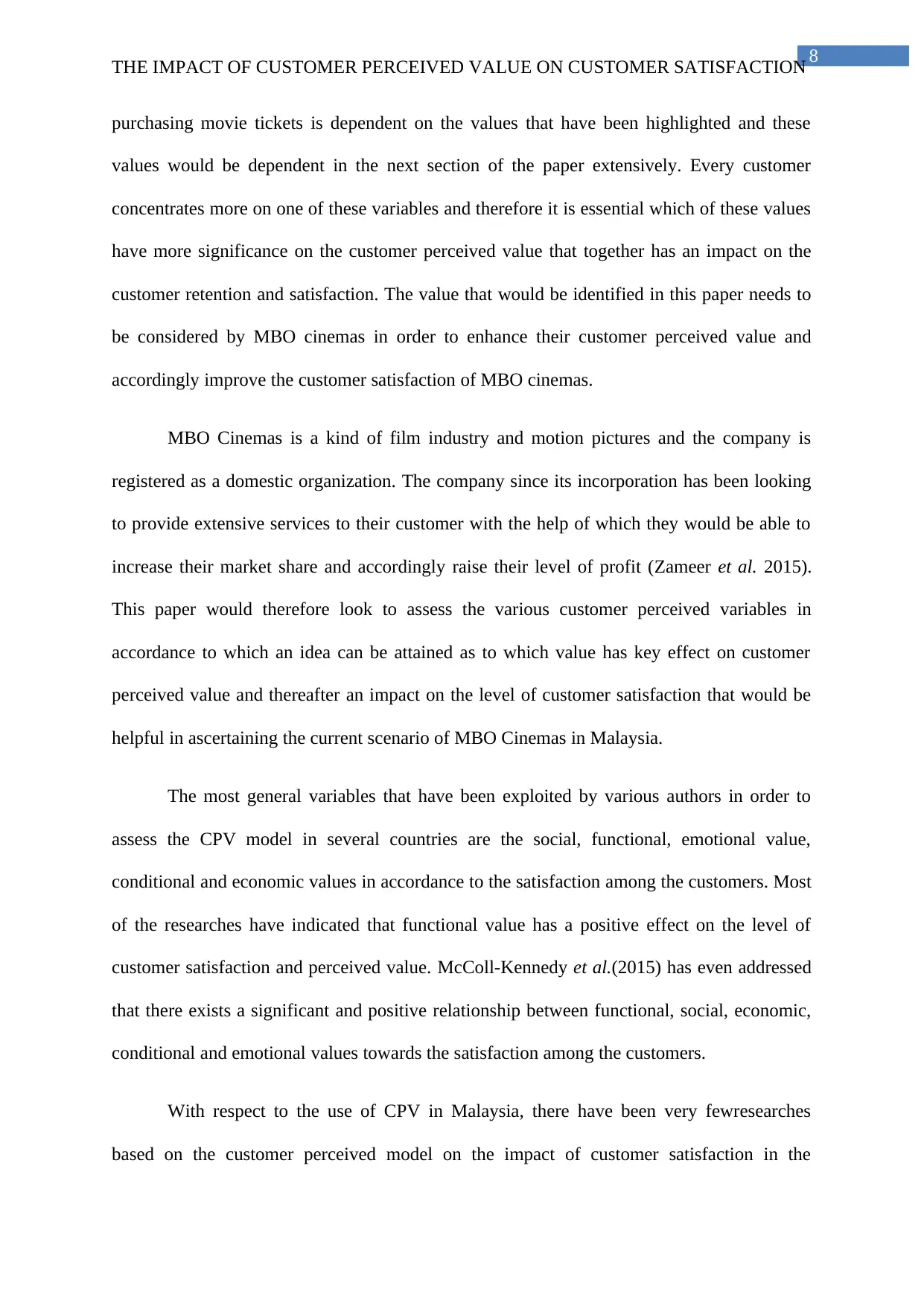
8
THE IMPACT OF CUSTOMER PERCEIVED VALUE ON CUSTOMER SATISFACTION
purchasing movie tickets is dependent on the values that have been highlighted and these
values would be dependent in the next section of the paper extensively. Every customer
concentrates more on one of these variables and therefore it is essential which of these values
have more significance on the customer perceived value that together has an impact on the
customer retention and satisfaction. The value that would be identified in this paper needs to
be considered by MBO cinemas in order to enhance their customer perceived value and
accordingly improve the customer satisfaction of MBO cinemas.
MBO Cinemas is a kind of film industry and motion pictures and the company is
registered as a domestic organization. The company since its incorporation has been looking
to provide extensive services to their customer with the help of which they would be able to
increase their market share and accordingly raise their level of profit (Zameer et al. 2015).
This paper would therefore look to assess the various customer perceived variables in
accordance to which an idea can be attained as to which value has key effect on customer
perceived value and thereafter an impact on the level of customer satisfaction that would be
helpful in ascertaining the current scenario of MBO Cinemas in Malaysia.
The most general variables that have been exploited by various authors in order to
assess the CPV model in several countries are the social, functional, emotional value,
conditional and economic values in accordance to the satisfaction among the customers. Most
of the researches have indicated that functional value has a positive effect on the level of
customer satisfaction and perceived value. McColl-Kennedy et al.(2015) has even addressed
that there exists a significant and positive relationship between functional, social, economic,
conditional and emotional values towards the satisfaction among the customers.
With respect to the use of CPV in Malaysia, there have been very fewresearches
based on the customer perceived model on the impact of customer satisfaction in the
THE IMPACT OF CUSTOMER PERCEIVED VALUE ON CUSTOMER SATISFACTION
purchasing movie tickets is dependent on the values that have been highlighted and these
values would be dependent in the next section of the paper extensively. Every customer
concentrates more on one of these variables and therefore it is essential which of these values
have more significance on the customer perceived value that together has an impact on the
customer retention and satisfaction. The value that would be identified in this paper needs to
be considered by MBO cinemas in order to enhance their customer perceived value and
accordingly improve the customer satisfaction of MBO cinemas.
MBO Cinemas is a kind of film industry and motion pictures and the company is
registered as a domestic organization. The company since its incorporation has been looking
to provide extensive services to their customer with the help of which they would be able to
increase their market share and accordingly raise their level of profit (Zameer et al. 2015).
This paper would therefore look to assess the various customer perceived variables in
accordance to which an idea can be attained as to which value has key effect on customer
perceived value and thereafter an impact on the level of customer satisfaction that would be
helpful in ascertaining the current scenario of MBO Cinemas in Malaysia.
The most general variables that have been exploited by various authors in order to
assess the CPV model in several countries are the social, functional, emotional value,
conditional and economic values in accordance to the satisfaction among the customers. Most
of the researches have indicated that functional value has a positive effect on the level of
customer satisfaction and perceived value. McColl-Kennedy et al.(2015) has even addressed
that there exists a significant and positive relationship between functional, social, economic,
conditional and emotional values towards the satisfaction among the customers.
With respect to the use of CPV in Malaysia, there have been very fewresearches
based on the customer perceived model on the impact of customer satisfaction in the
⊘ This is a preview!⊘
Do you want full access?
Subscribe today to unlock all pages.

Trusted by 1+ million students worldwide
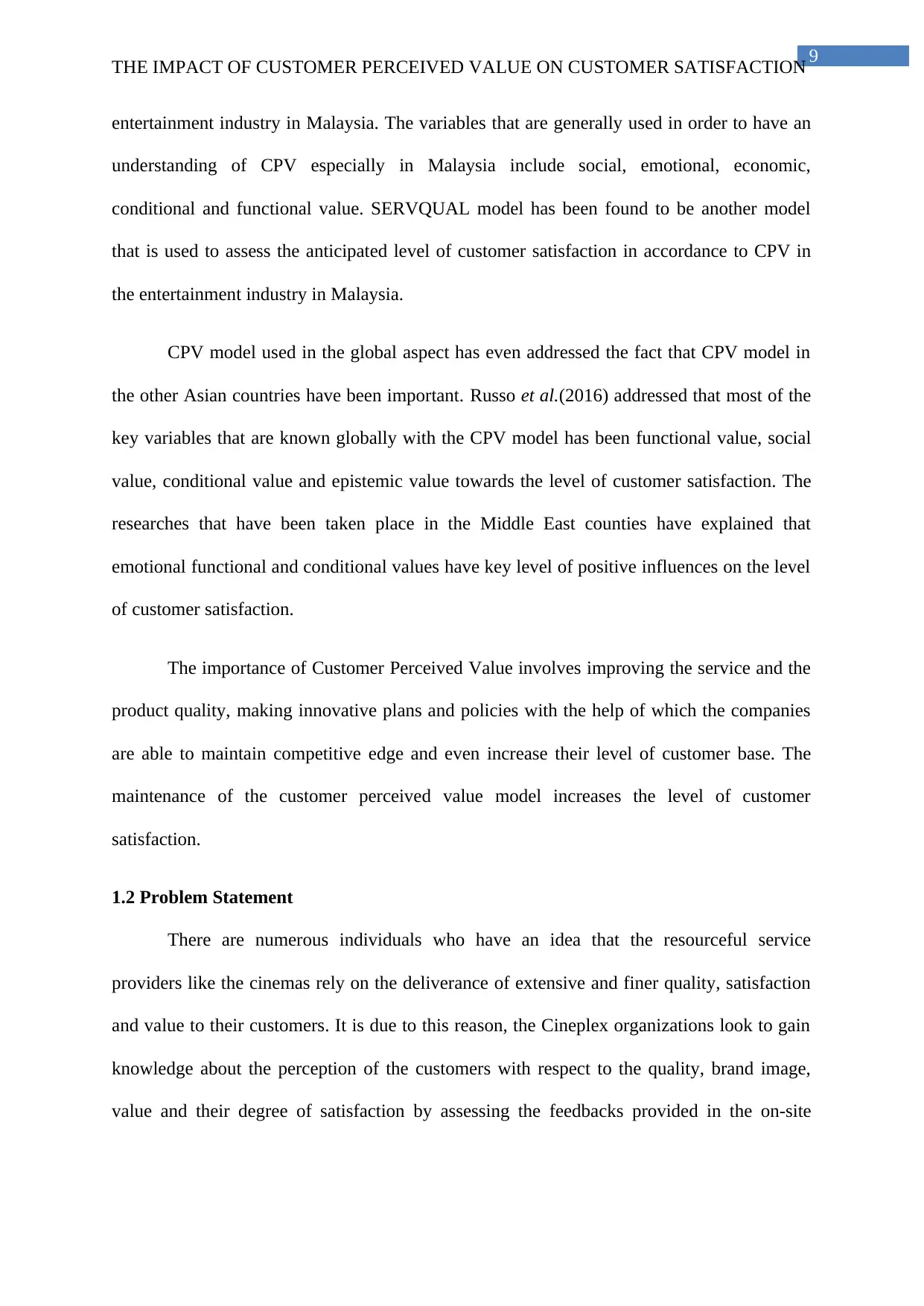
9
THE IMPACT OF CUSTOMER PERCEIVED VALUE ON CUSTOMER SATISFACTION
entertainment industry in Malaysia. The variables that are generally used in order to have an
understanding of CPV especially in Malaysia include social, emotional, economic,
conditional and functional value. SERVQUAL model has been found to be another model
that is used to assess the anticipated level of customer satisfaction in accordance to CPV in
the entertainment industry in Malaysia.
CPV model used in the global aspect has even addressed the fact that CPV model in
the other Asian countries have been important. Russo et al.(2016) addressed that most of the
key variables that are known globally with the CPV model has been functional value, social
value, conditional value and epistemic value towards the level of customer satisfaction. The
researches that have been taken place in the Middle East counties have explained that
emotional functional and conditional values have key level of positive influences on the level
of customer satisfaction.
The importance of Customer Perceived Value involves improving the service and the
product quality, making innovative plans and policies with the help of which the companies
are able to maintain competitive edge and even increase their level of customer base. The
maintenance of the customer perceived value model increases the level of customer
satisfaction.
1.2 Problem Statement
There are numerous individuals who have an idea that the resourceful service
providers like the cinemas rely on the deliverance of extensive and finer quality, satisfaction
and value to their customers. It is due to this reason, the Cineplex organizations look to gain
knowledge about the perception of the customers with respect to the quality, brand image,
value and their degree of satisfaction by assessing the feedbacks provided in the on-site
THE IMPACT OF CUSTOMER PERCEIVED VALUE ON CUSTOMER SATISFACTION
entertainment industry in Malaysia. The variables that are generally used in order to have an
understanding of CPV especially in Malaysia include social, emotional, economic,
conditional and functional value. SERVQUAL model has been found to be another model
that is used to assess the anticipated level of customer satisfaction in accordance to CPV in
the entertainment industry in Malaysia.
CPV model used in the global aspect has even addressed the fact that CPV model in
the other Asian countries have been important. Russo et al.(2016) addressed that most of the
key variables that are known globally with the CPV model has been functional value, social
value, conditional value and epistemic value towards the level of customer satisfaction. The
researches that have been taken place in the Middle East counties have explained that
emotional functional and conditional values have key level of positive influences on the level
of customer satisfaction.
The importance of Customer Perceived Value involves improving the service and the
product quality, making innovative plans and policies with the help of which the companies
are able to maintain competitive edge and even increase their level of customer base. The
maintenance of the customer perceived value model increases the level of customer
satisfaction.
1.2 Problem Statement
There are numerous individuals who have an idea that the resourceful service
providers like the cinemas rely on the deliverance of extensive and finer quality, satisfaction
and value to their customers. It is due to this reason, the Cineplex organizations look to gain
knowledge about the perception of the customers with respect to the quality, brand image,
value and their degree of satisfaction by assessing the feedbacks provided in the on-site
Paraphrase This Document
Need a fresh take? Get an instant paraphrase of this document with our AI Paraphraser
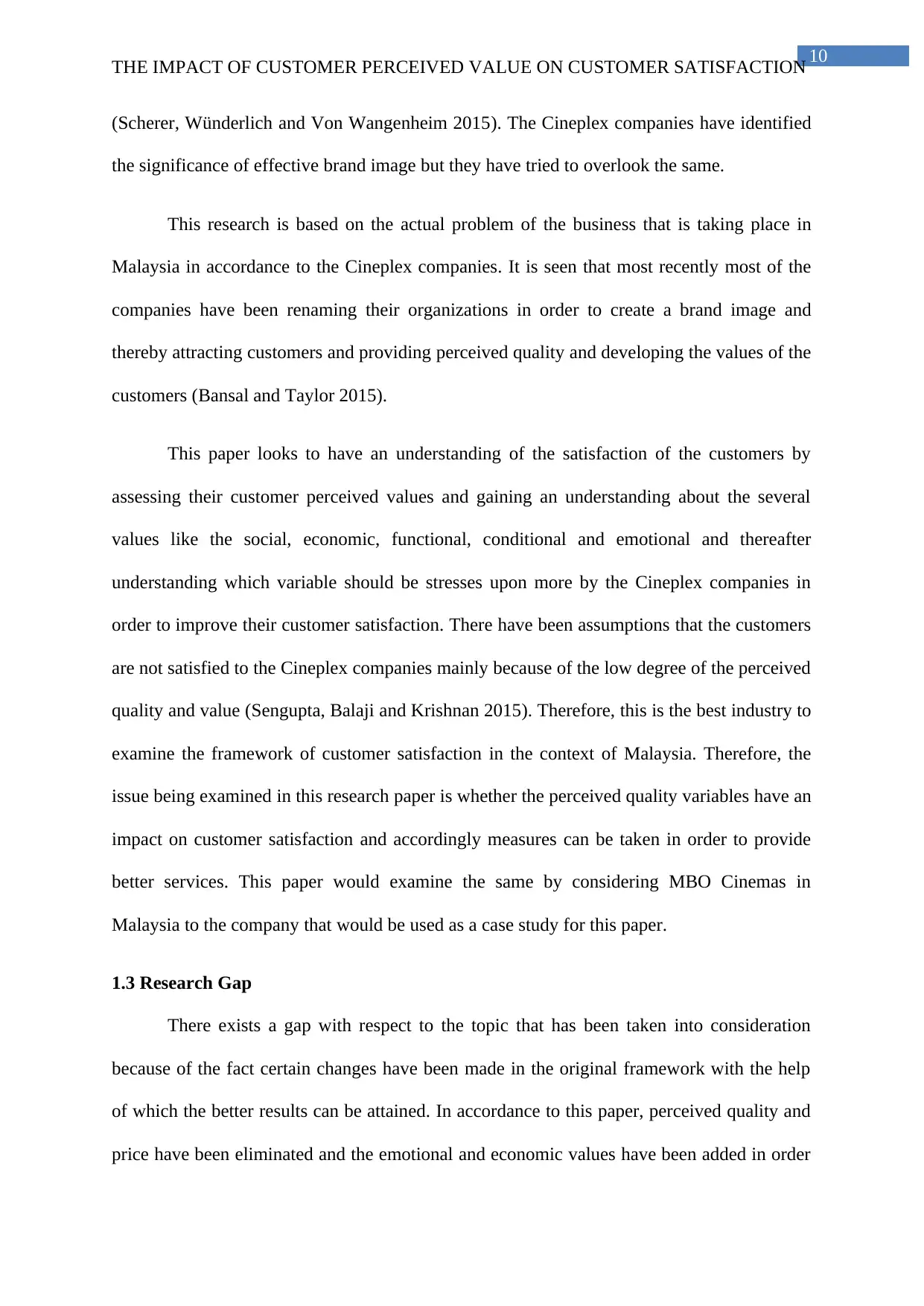
10
THE IMPACT OF CUSTOMER PERCEIVED VALUE ON CUSTOMER SATISFACTION
(Scherer, Wünderlich and Von Wangenheim 2015). The Cineplex companies have identified
the significance of effective brand image but they have tried to overlook the same.
This research is based on the actual problem of the business that is taking place in
Malaysia in accordance to the Cineplex companies. It is seen that most recently most of the
companies have been renaming their organizations in order to create a brand image and
thereby attracting customers and providing perceived quality and developing the values of the
customers (Bansal and Taylor 2015).
This paper looks to have an understanding of the satisfaction of the customers by
assessing their customer perceived values and gaining an understanding about the several
values like the social, economic, functional, conditional and emotional and thereafter
understanding which variable should be stresses upon more by the Cineplex companies in
order to improve their customer satisfaction. There have been assumptions that the customers
are not satisfied to the Cineplex companies mainly because of the low degree of the perceived
quality and value (Sengupta, Balaji and Krishnan 2015). Therefore, this is the best industry to
examine the framework of customer satisfaction in the context of Malaysia. Therefore, the
issue being examined in this research paper is whether the perceived quality variables have an
impact on customer satisfaction and accordingly measures can be taken in order to provide
better services. This paper would examine the same by considering MBO Cinemas in
Malaysia to the company that would be used as a case study for this paper.
1.3 Research Gap
There exists a gap with respect to the topic that has been taken into consideration
because of the fact certain changes have been made in the original framework with the help
of which the better results can be attained. In accordance to this paper, perceived quality and
price have been eliminated and the emotional and economic values have been added in order
THE IMPACT OF CUSTOMER PERCEIVED VALUE ON CUSTOMER SATISFACTION
(Scherer, Wünderlich and Von Wangenheim 2015). The Cineplex companies have identified
the significance of effective brand image but they have tried to overlook the same.
This research is based on the actual problem of the business that is taking place in
Malaysia in accordance to the Cineplex companies. It is seen that most recently most of the
companies have been renaming their organizations in order to create a brand image and
thereby attracting customers and providing perceived quality and developing the values of the
customers (Bansal and Taylor 2015).
This paper looks to have an understanding of the satisfaction of the customers by
assessing their customer perceived values and gaining an understanding about the several
values like the social, economic, functional, conditional and emotional and thereafter
understanding which variable should be stresses upon more by the Cineplex companies in
order to improve their customer satisfaction. There have been assumptions that the customers
are not satisfied to the Cineplex companies mainly because of the low degree of the perceived
quality and value (Sengupta, Balaji and Krishnan 2015). Therefore, this is the best industry to
examine the framework of customer satisfaction in the context of Malaysia. Therefore, the
issue being examined in this research paper is whether the perceived quality variables have an
impact on customer satisfaction and accordingly measures can be taken in order to provide
better services. This paper would examine the same by considering MBO Cinemas in
Malaysia to the company that would be used as a case study for this paper.
1.3 Research Gap
There exists a gap with respect to the topic that has been taken into consideration
because of the fact certain changes have been made in the original framework with the help
of which the better results can be attained. In accordance to this paper, perceived quality and
price have been eliminated and the emotional and economic values have been added in order
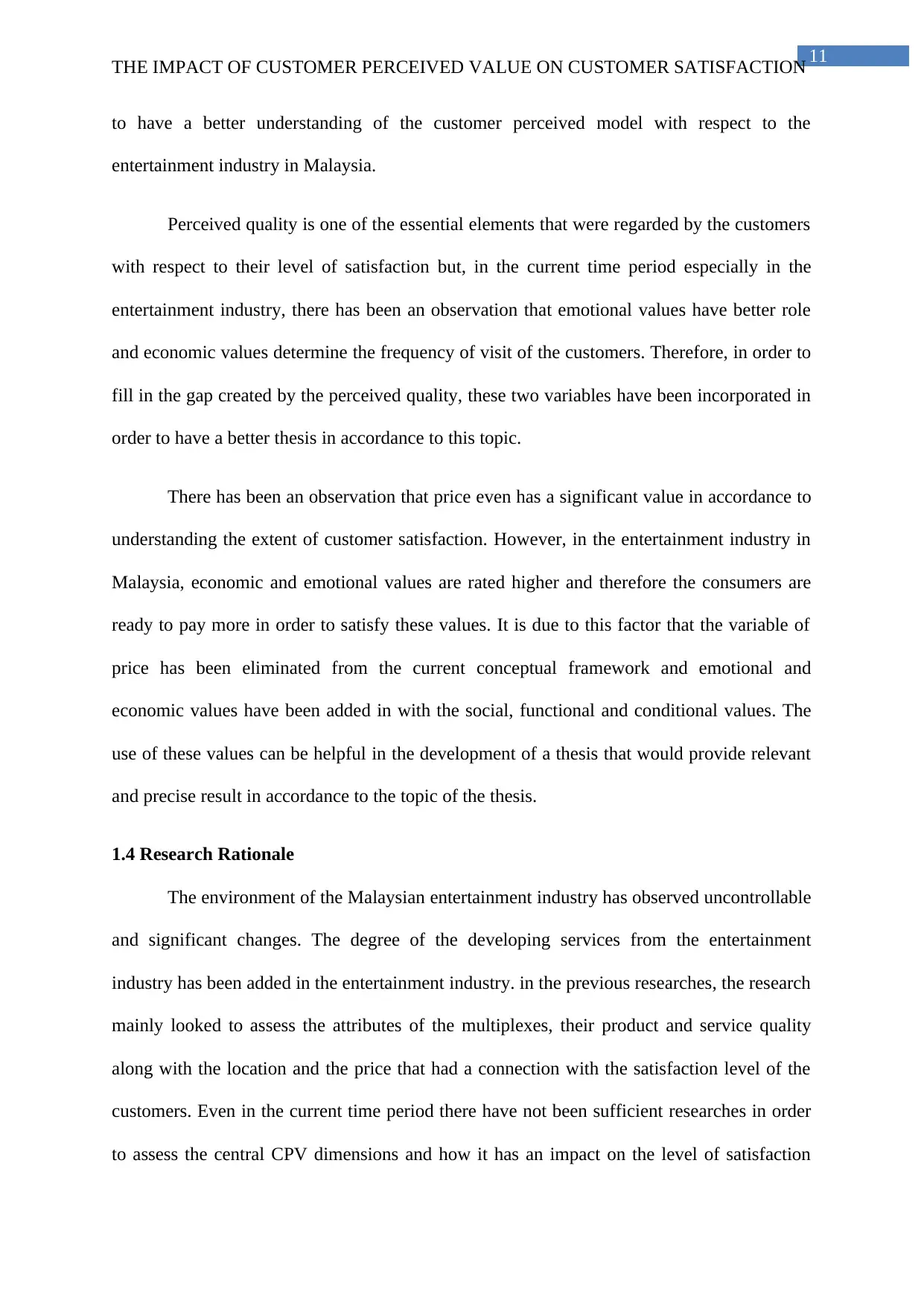
11
THE IMPACT OF CUSTOMER PERCEIVED VALUE ON CUSTOMER SATISFACTION
to have a better understanding of the customer perceived model with respect to the
entertainment industry in Malaysia.
Perceived quality is one of the essential elements that were regarded by the customers
with respect to their level of satisfaction but, in the current time period especially in the
entertainment industry, there has been an observation that emotional values have better role
and economic values determine the frequency of visit of the customers. Therefore, in order to
fill in the gap created by the perceived quality, these two variables have been incorporated in
order to have a better thesis in accordance to this topic.
There has been an observation that price even has a significant value in accordance to
understanding the extent of customer satisfaction. However, in the entertainment industry in
Malaysia, economic and emotional values are rated higher and therefore the consumers are
ready to pay more in order to satisfy these values. It is due to this factor that the variable of
price has been eliminated from the current conceptual framework and emotional and
economic values have been added in with the social, functional and conditional values. The
use of these values can be helpful in the development of a thesis that would provide relevant
and precise result in accordance to the topic of the thesis.
1.4 Research Rationale
The environment of the Malaysian entertainment industry has observed uncontrollable
and significant changes. The degree of the developing services from the entertainment
industry has been added in the entertainment industry. in the previous researches, the research
mainly looked to assess the attributes of the multiplexes, their product and service quality
along with the location and the price that had a connection with the satisfaction level of the
customers. Even in the current time period there have not been sufficient researches in order
to assess the central CPV dimensions and how it has an impact on the level of satisfaction
THE IMPACT OF CUSTOMER PERCEIVED VALUE ON CUSTOMER SATISFACTION
to have a better understanding of the customer perceived model with respect to the
entertainment industry in Malaysia.
Perceived quality is one of the essential elements that were regarded by the customers
with respect to their level of satisfaction but, in the current time period especially in the
entertainment industry, there has been an observation that emotional values have better role
and economic values determine the frequency of visit of the customers. Therefore, in order to
fill in the gap created by the perceived quality, these two variables have been incorporated in
order to have a better thesis in accordance to this topic.
There has been an observation that price even has a significant value in accordance to
understanding the extent of customer satisfaction. However, in the entertainment industry in
Malaysia, economic and emotional values are rated higher and therefore the consumers are
ready to pay more in order to satisfy these values. It is due to this factor that the variable of
price has been eliminated from the current conceptual framework and emotional and
economic values have been added in with the social, functional and conditional values. The
use of these values can be helpful in the development of a thesis that would provide relevant
and precise result in accordance to the topic of the thesis.
1.4 Research Rationale
The environment of the Malaysian entertainment industry has observed uncontrollable
and significant changes. The degree of the developing services from the entertainment
industry has been added in the entertainment industry. in the previous researches, the research
mainly looked to assess the attributes of the multiplexes, their product and service quality
along with the location and the price that had a connection with the satisfaction level of the
customers. Even in the current time period there have not been sufficient researches in order
to assess the central CPV dimensions and how it has an impact on the level of satisfaction
⊘ This is a preview!⊘
Do you want full access?
Subscribe today to unlock all pages.

Trusted by 1+ million students worldwide
1 out of 104
Related Documents
Your All-in-One AI-Powered Toolkit for Academic Success.
+13062052269
info@desklib.com
Available 24*7 on WhatsApp / Email
![[object Object]](/_next/static/media/star-bottom.7253800d.svg)
Unlock your academic potential
Copyright © 2020–2026 A2Z Services. All Rights Reserved. Developed and managed by ZUCOL.





